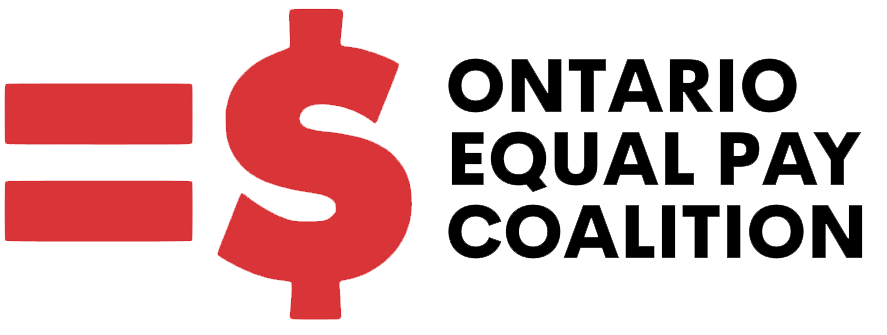Ontario Pay Equity Advocacy Timeline
1985
With a strategy of working with all political parties who support ending pay discrimination against women, the Coalition gained the support of both the New Democratic Party and the Liberal Party which resulted in pay equity being part of the Liberal/NDP Accord when the Liberals came to power in 1985.
As such, the Liberal Government issued a Green Paper on Pay Equity in 1985 which called for input on the design of the law. After two years of consultations, the Legislature passed the 1987 Pay Equity Act, effective January 1, 1988.
1987
The Ontario Pay Equity Act was introduced in 1987, and was the first important step to recognizing the value of women’s work and eliminating discrimination.
Pay equity plans identified substantial pay gaps where “women’s work” was being paid substantially less than “men’s work” because of systemic discrimination in traditional wage-setting policies, and the Act required employers to take positive steps toward closing this gap.
Many private and public sector employers, including the Ontario Government itself were required for the first time to recognize the true value of women’s work and begin to pay for it. This was unprecedented.
1988
The Pay Equity Act came into effect.
The government recognized that the job-to-job comparison method could not be implemented in predominantly female workplaces (e.g. child care centres), where the wages are the lowest, as there were insufficient male job classes with which women could compare their wages. To remedy this, the Act required a report on wage discrimination in these workplaces to develop an appropriate new comparison method.
1989
Pay Equity Commission Report recommended two new comparison methods:
- Proportional: Where there are a small number of male job classes in a workplace, value could be assigned to the work performed by those classes, allowing women to identify the appropriate wage rate they should receive for the work they do.
- Proxy: In workplaces with fewer or no male job classes, a similar larger workplace nearby was used as a “proxy” comparator, because that workplace had already identified the wage gap between men and women using the job-to-job method. Eg. a nurse at a nursing home can be compared to a nurse at a municipal home for the aged.
This provided women in predominantly female workplace with a mechanism to identify their discriminatory pay gap.
1990
This was the start date for pay equity for the job-to-job method. Then Minister of Labour Bob McKenzie announced the intention to implement proportional and proxy comparison methods for women in predominantly female workplaces and to fund all public sector pay equity adjustments.
1991
Then Treasurer Floyd Laughren committed to fully funding public sector pay equity in an amount to total $1 billion annually at maturity. Chair of Management Board of Cabinet also committed to 100% funding for proxy sector, noting that pay equity is a right not a luxury, and that recessions hit lowest paid workers the hardest.
1993
Bill 102 passed, legislating proportional and proxy pay equity.
Minister of Labour again committed to providing full funding for pay equity adjustments. Ontario issued Pay Equity Funding Guidelines and reiterated commitment to 100% fund proxy pay equity. Ontario committed to fund 3% of payroll in the first year and 1% for each following year until pay equity is achieved.
In some cases, the Ontario Government and larger public sector employers were being found to be “employers” under the Act and responsible for pay equity, so the Ontario Government in the early 1990s agreed to fund all public sector pay equity adjustments. In exchange, the Government included an amendment which prevented the Ontario Government from being found as an employer of another entity in the public sector. As well, after lobbying efforts by many groups, Ontario passed the Employment Equity Act.
1994
This was the proportional values and proxy pay equity adjustments start date. Predominantly female workplaces began using proxy comparators to identify the discriminatory wage gaps between workers in comparable male and female job classes. Unions and employers began preparing “proxy plans”.
1995
Tories elected.
When the Progressive Conservative government came to power in 1995, Ontario ‘s leadership in the pay equity field ended. The Government quickly moved to repeal the proxy comparison sections of the Act which covered approximately 100,000 public sector women, ended the funding of such adjustments, eliminated funding for Pay Equity Legal Clinic, repealed the Employment Equity Act, and repealed Labour Relations Act provisions which had assisted and facilitated the union organizing of women workers.
Tories capped public sector pay equity funding at $500 million annually as follows:
- Ontario Public Service: $120 million
- Workplaces using Job-to-Job/Proportional Methods: $249 million
- Proxy Workplaces (3% of employer’s payroll): $62 million
- Pay Equity Downpayment Program: $50 million
- Special (eg. Homemaker wage rate reform): $19 million
Total: $500 million
Ontario introduced Schedule J to Bill 26 – The Savings and Restructuring Act, 1995 amending the Pay Equity Act. Schedule J abolishes the proxy method of comparison and eliminates the obligation for proxy workplaces to pay further adjustments above the cap 3% of payroll.
1996
Schedule J passed – Proxy Comparison method abolished, funding capped.
Charter Challenge – SEIU Local 204 and two women launched a challenge of Schedule J.
1997
Government defended the challenge, stating the proxy method did not identify pay discrimination and was too expensive to fund. The government had therefore taken away proxy employers’ legal obligations to pay further equity adjustments.
Mr. Justice O’Leary ruled in SEIU Local 204 v. Attorney General that Schedule J violates women’s equality rights under section 15 of the Charter in that it discriminates against women in proxy sector workplaces, the women whose wages are most discriminatory compared to men. Justice O’Leary also ruled that the proxy comparison method was a valid mechanism for identifying wage discrimination. Then Ontario Premier Mike Harris states Ontario would “honour and support our pay equity commitments.” Finance Minister Ernie Eves announced that Ontario would not appeal the decision and would make sure proxy employers “not only obey the decision but have the ability to live up to and fund the decision.” Ernie Eves announced $140 million in retroactive proxy pay equity funding, to be paid on a one-time basis to cover proxy pay equity adjustments owing for 1995, 1996 and 1997.
The $500 million cap for pay equity for all public sector employees, including proxy workplaces, was still in place. Employers and employees asked to agree on a fair distribution of the annual capped pay equity funding.
1998
The Pay Equity Commission advised employers that proxy was reinstated and that they must make annual 1% of payroll adjustments until pay equity is achieved. Public sector employers using job-to-job and proportional to achieve pay equity achieve pay equity Jan.1.
KPMG was retained by Government to consult with public sector employers and employees on how to divide $500 million. KPMG reported unanimous message: Government must fully fund pay equity adjustments for all public sector women regardless of the method of comparison. Pay equity is not possible without funding. Government refuses to release the report.
1999
Annual proxy pay equity adjustments not paid.
Government paid retroactive adjustments owing up to January 1, 1998, and advised employers that they were responsible for all further annual adjustments required by the Act.
Employers, unions and the Equal Pay Coalition lobbied Government to abide by SEIU 204 decision and fully fund proxy pay equity. Minister of Finance replied: pay equity is “part of the cost of doing business,” proxy employers “are responsible for meeting their current and future obligations.”
2000
Annual proxy pay equity adjustments not paid.
Government told proxy employers they must find funds for pay equity within their existing budgets. Pay Equity Commission told proxy employers that layoffs, reducing hours of work, or eliminating positions in order to find money for pay equity adjustments may violate the Pay Equity Act.
The Ministry of Labour 2000-2001 Business Plan stated that one of its core businesses was ensuring enforcement of the Pay Equity Act and a target was increasing rates of compliance with the Act by 20% over the next 5 years.
Proxy employers and organizations wrote continuously to the Ministry requesting pay equity funding, stating that they could not continue to provide necessary public services and meet their obligations under the Pay Equity Act without adequate funding. Ministries continued to refuse further funding.
Government released a budget trumpeting a booming economy, a balanced budget achieved one year early, an over-achievement in the deficit reduction target, the Contingency Reserve Fund doubled to $1 billion, while generating necessary revenues to “pay for valued public services.” At the same time as government publicized the strength of the economy it was saying no to paying women performing public services equitable wages.
The Pay Equity Hearings Tribunal issued decision in Kensington Village Nursing Home v. SEIU Local 220, stating lack of government funding is not a defence to a proxy employer’s failure to provide pay equity adjustments.
Third Quarter figures issued by Government noted projected 2000-2001 surplus of $1,411 million, up $45 million.
2001
Annual proxy pay equity adjustments not paid. Total owing to women now $140 million.
Charter challenge filed by CUPE, ONA, OPSEU, SEIU, USWA and 4 female applicants. Applicants asked the Court to order the government to provide the funds needed for pay equity. Hearing anticipated in the Winter of 2002 – 2003.
2003
Charter challenge settled, resulting in payments of $414 million to 100,000 women over 3 years.
The claim asserted that the government was perpetuating wage-based gender discrimination by failing to fund on-going pay equity adjustments to workers in predominantly female workplaces who use the proxy method to identify the discriminatory wage gap between themselves and male job classes. This violates Section 15 of the Canadian Charter of Rights and Freedoms.
The government agreed to make its best efforts to distribute the funding to proxy pay equity employers “as quickly as possible” and no later than the following dates:
- The 2003-2004 funding for base pay equity adjustments will be provided no later than December 31, 2003.
- The remaining 2003-2004 funding for current and retroactive pay equity liabilities will start no later than March 31, 2004 and will be paid out in part over the next 3 years.
- Funding for the 2004-5 and 2005-6 fiscal years will be provided to employers as part of the customary budgeting process.
- The agreement also includes accountability measures to insure that proxy employers comply with their pay equity obligations and that the funding required for any such adjustments is properly reflected in budget requests.
2006
Proxy funding under 2003 settlement ended.
2008
This year marked the 20th anniversary of the Pay Equity Act. The Coalition released the Framework for Action on Pay Equity in Ontario which called upon the Provincial government to take action to end the gender pay gap crisis in the Ontario.
2014
Government estimate of the year in which women in the proxy sector would achieve pay equity if payments of 1% payroll were made according to the Pay Equity Act. The annual mature cost of proxy pay equity by this date is at estimated at $484 million annually.
In April 2014, the provincial government agreed that Equal Pay Day would be held on an annual basis.
Lessons to be Learned from Enforcing the Pay Equity Act in Ontario
Ontario’s pay equity law continues to be internationally recognized as one of the world’s most effective laws in redressing the wage gap. This is because of the comprehensiveness of its model which combines legislative, collective bargaining, adjudicative and enforcement mechanisms to arrive at an effective pay equity result.
Ontario’s proactive model brings together the strengths of a human resource planning process and a human rights enforcement approach which allows employers and unions to work together to meet the law’s time limits and obligations. This encourages a results-based, problem-solving approach and helps to avoid adversarial fault-finding. It recognizes that wage discrimination is not an individual but a systemic problem which requires a systemic solution. Placing the responsibility on employers also recognizes that it is unfair to place the burden of enforcing the law on individual women who are already disadvantaged. Because the law requires all employers to comply, it meets employers concerns that there be a level playing field for businesses.
Unions achieved the greatest successes in redressing the wage gap for women’s work under the Act in terms of real dollars. This is because the Act required employers to negotiate pay equity plans with any bargaining agent whereas non-organized employers were left on their own to redress the wage gap without any outside control unless an employee complaint was filed. Unions played a particularly important role in negotiating plans to provide for pay equity in the traditionally low-paying female ghettoized service occupations such as hospitals, nursing homes, community services, shelters and home support services.
This is not to say that Ontario’s law and enforcement process did not have weaknesses. Pay equity has been achieved for some but not nearly all women in Ontario. Critical to the future successful implementation of pay equity in Ontario is addressing the needs of non-unionized women. Often disadvantaged not only by gender, but also by race, ethnicity and disability, non-organized women have for the most part been unable to effectively access the benefits of the legislation. This problem cries out for a strengthened law with monitoring, not no law as some critics maintain. Special supports must be given to non-organized women, such as funding for pay equity legal clinics.
An expert commission and hearings tribunal is also essential to effective enforcement. Commission staff provide valuable advice to employers, unions and non-organized employees in ways that help avoid unnecessary costs, reduce time and promote consistency. High consultants fees can be avoided if employers are willing to use a commission’s resources to help them comply rather than hiring a consultant to find loopholes. The Equal Pay Coalition is lobbying the Ontario Government to ensure that such measures are taken.




